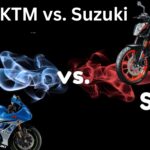When comparing dirt bikes and motorcycles, it is clear that they have many similarities. Both have two wheels and are designed for riders who enjoy the thrill of biking. However, they also have distinct differences in terms of design, function, and riding experience. This article looks at how dirt bikes and street motorcycles differ. It talks about their features and gives expert reviews. Plus, it answers common questions.
Dirt Bikes vs. Street Motorcycles: A Detailed Comparison
Dirt bikes and street motorcycles are designed for different terrains and purposes. The main differences are size, weight, tires, suspension, seat position, and materials.
Size and Weight
Dirt bikes are generally smaller and lighter than street motorcycles. Their lightweight design allows riders to maneuver easily over rough and uneven terrains. They are built with minimal components to keep them light and agile. Street motorcycles are heavier and larger. They have complex parts. These include larger fuel tanks, storage compartments, and advanced suspension systems. These features provide comfort for long rides.
Frame and Build Material
Dirt bikes have compact, lightweight frames made of plastic and lightweight metal alloys. This ensures flexibility and durability on challenging terrains. Street motorcycles have bigger and heavier metal frames. These frames give stability and support on highways and paved roads.
Tires and Traction
Dirt bikes come with knobby tires that offer excellent grip on loose dirt, mud, sand, and rocky surfaces. These tires are designed to dig into the terrain, providing traction and control. Street motorcycles have wide, smooth tires. These tires offer stability and maximum contact with the road. This design helps improve speed and control on paved surfaces.
Suspension System
Dirt bikes feature a more advanced suspension system, designed to absorb shocks from rough terrains. This includes hydraulic shocks and long-travel suspensions. They help riders handle jumps and bumps easily. Street motorcycles have a stiffer suspension. This system is made for smooth roads, not for off-road conditions.
Seat Positioning and Comfort
Dirt bike seats are narrower and positioned higher to allow better control and movement. Riding in a forward-leaning position helps riders shift their weight easily on rough terrain. Street motorcycles have wider and more cushioned seats, providing comfort for long-distance travel. The seating position is usually more relaxed, allowing riders to maintain an upright posture.
Performance and Riding Experience
Speed and Acceleration
Street motorcycles are built for speed and can easily reach high speeds due to their powerful engines and aerodynamic design. Dirt bikes, however, focus on acceleration and torque rather than top speed. They are designed to navigate obstacles rather than cruise at high speeds.
Braking System
Dirt bikes have smaller brake rotors, with some models featuring a single front disc brake. Street motorcycles have bigger brake discs and dual-disc systems. This gives them better stopping power when going fast.
Fuel Efficiency and Tank Capacity
Dirt bikes have smaller fuel tanks, making them lightweight but requiring frequent refueling. Street motorcycles have larger fuel tanks, designed for long-distance travel without frequent stops.
Cost and Maintenance
Dirt bikes generally cost between $8,000 to $9,000 for top-brand models. Over time, their resale value drops. They also need more maintenance because of the tough conditions they face. Street motorcycles are heavier and built to last. They need less maintenance but often cost more to buy and fix.
Electric Dirt Bikes: The Future of Off-Roading
With advancements in technology, electric dirt bikes are becoming more popular. These bikes run on battery-powered engines. They don’t use traditional gasoline engines. This makes them quieter and better for the environment than regular dirt bikes. They are suitable for both beginners and experienced riders.
Reviews and Ratings
Dirt Bike Reviews
- Yamaha YZ250F – Rated 4.8/5: Excellent performance, lightweight, and great suspension for off-road riding.
- Honda CRF450R – Rated 4.7/5: Powerful engine and reliable build quality, suitable for professionals.
- KTM 250 SX-F – Rated 4.6/5: Impressive acceleration and handling but slightly expensive.
Street Motorcycle Reviews
- Honda CBR500R – Rated 4.8/5: Affordable, beginner-friendly, and fuel-efficient.
- Kawasaki Ninja 650 – Rated 4.7/5: Great performance and stylish design.
- Yamaha MT-07 – Rated 4.6/5: Comfortable ride with good acceleration, perfect for city riding.
Frequently Asked Questions (FAQs)
1. Which is safer, a dirt bike or a street motorcycle?
Dirt bikes are generally safer because they are used in controlled environments such as trails and tracks. Street motorcycles, however, are exposed to traffic hazards, making them riskier.
2. Can you use a dirt bike on the street?
Most dirt bikes are not street-legal. However, some dual-sport models are designed to be used on both off-road trails and city streets.
3. What is the lifespan of a dirt bike vs. a street motorcycle?
A dirt bike usually lasts 5 to 10 years with regular care. In contrast, a street motorcycle can last 15 to 20 years if it’s well maintained.
4. Are electric dirt bikes better than gas-powered ones?
Electric dirt bikes are quieter, require less maintenance, and are eco-friendly. However, gas-powered dirt bikes offer better performance for long-distance riding.
5. What should I choose: a dirt bike or a street motorcycle?
If you enjoy off-road adventures, jumps, and rough terrains, a dirt bike is the best choice. If you prefer long highway rides and high-speed cruising, a street motorcycle is the better option.
Conclusion
Both dirt bikes and street motorcycles offer unique riding experiences. Dirt bikes are great for agility and off-road riding. Street motorcycles, on the other hand, are better for speed, comfort, and long trips. Choosing between the two depends on your riding style, terrain preference, and experience level. If you love off-road thrills or need a dependable road bike, knowing the differences will help you decide better.






